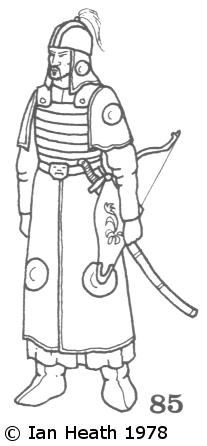
Register a SNAP EBT card with Amazon
MONGOL HEAVY CAVALRYMAN
An extract from Armies and Enemies of the Crusades 1096-1291by Ian Heath



85. MONGOL HEAVY CAVALRYMAN
Contemporaries offer a fair number of descriptions of Mongol armour, albeit generally vague.
Carpini records iron or steel helmets with leather coifs or aventails, mail coreselets, and leather body-armour of overlapping strips; he also gives an accurate and detailed description of lamellar armour used for both men and horses. Marco Polo says they wore a very strong armour 'of leather that has been boiled', i.e. cuir bouilli. Matthew Paris also records leather armour, of oxhides strengthened with iron plates, adding the improbable but amusing detail that only their chests were protected, their backs being left unarmoured to discourage them from running away! Thomas of Spalatro describes 'armour of buffalo hides with scales fastened on it' (possibly lamellar) as well as iron or leather helmets. The Emperor Frederick II records 'untanned hides of oxen, horses and asses' reinforced with plates of iron which were somehow stitched in. He also mentions that there were many considerably better-equipped from the spoils of their defeated enemies (he actually says 'Christians', therefore Franks). Into this category fall iron helmets and armour of 'iron plates' of Persian origin and mail hauberks of Alan origin recorded in addition to hardened-leather armour by Rubreck. Metal armour was polished to a high shine.
Quite clearly leather was the commonest form of body-armour, constructed from 'overlapping pliable strips' according to Carpini. He records that the hide strips - about 3½ inches wide - were tightly sewn together 3 layers thick, then softened by boiling and shaped to fit. He adds that the hide was stiffened with bitumen, which would also have served to protect it from humidity. The whole armour consisted of front, back, arm and leg pieces, the front and back being joined at the shoulder (and sides, one assumes) by iron plates and buckles; see also 89.
The standard Mongol battle-formation required that 40% of the army were heavy cavalry, but William of Rubreck says only the officers and picked men wore armour and this is reitereated by Vincent de Beauvais, who adds that no more than 10% of the Mongols were armoured.